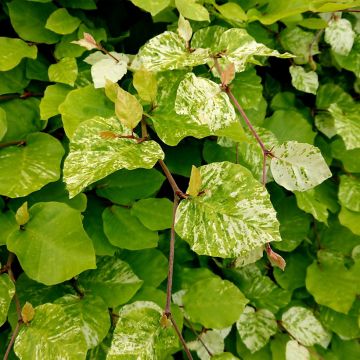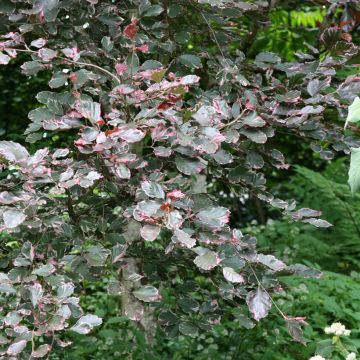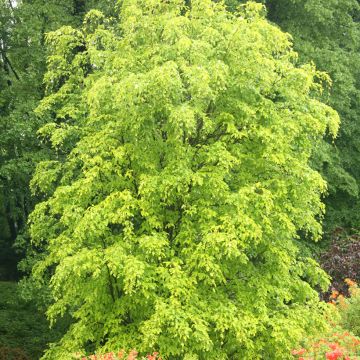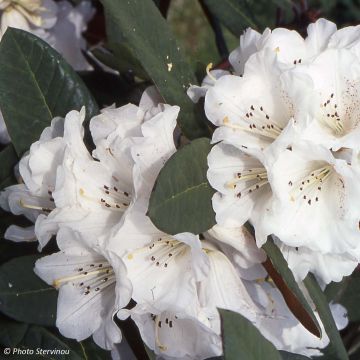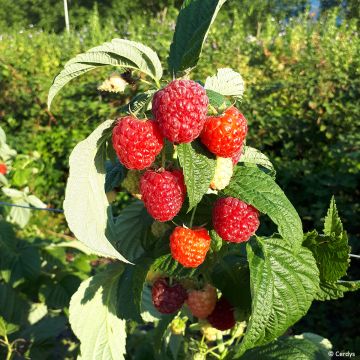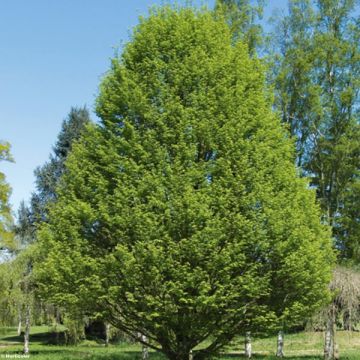

Fagus sylvatica Felderbach
Fagus sylvatica Felderbach
Fagus sylvatica 'Felderbach'
Beech
This item cannot be shipped to the selected country
Oversize package delivery charge from €6.90
More information
Schedule delivery date,
and select date in basket
This plant carries a 24 months recovery warranty
More information
We guarantee the quality of our plants for a full growing cycle, and will replace at our expense any plant that fails to recover under normal climatic and planting conditions.
Oversize package: home delivery by special carrier from €6.90 per order..
Express home delivery from €8.90.
Does this plant fit my garden?
Set up your Plantfit profile →
Description
Fagus sylvatica 'Felderbach' is a rare miniature variety of beech tree that has a strong presence due to its natural bonsai-like appearance. This small tree has an almost columnar habit and dense branching, with very small, shiny, dark green leaves that turn bronze to brown in autumn. It is a variety with undeniable sculptural appeal, ideal for planting as a specimen or in a container on a terrace.
The Common Beech, known in Latin as Fagus sylvatica, is an imposing tree. Its cylindrical trunk is covered with smooth, light grey bark. This tree can live for several centuries. Native to central Europe to the Caucasus, it is one of the most common tree species in European forests, reaching a height of 20m at maturity. Its reddish wood is used in cabinetmaking and for the production of wooden tools, toys, and firewood. It belongs to the Fagaceae family.
Fagus sylvatica 'Felderbach' is a horticultural selection of this species. It is a very slow-growing tree that forms a wide column. Its dimensions reach about 3m in height and 2m in width at the age of 15-20 years. With its dense branching, its natural shape can be enhanced by appropriate pruning, and it can even be trained as a bonsai. It is also distinguished by its highly ornamental foliage. Measuring only 2 to 3cm long, its leaves are oval-shaped with toothed edges. They are a shiny dark green from spring to summer. The leaf blades have prominent veins. In autumn, the foliage turns bronze before browning and remains on the branches for a long time before falling to the ground.
Hardy down to -25°C, the 'Felderbach' beech tree appreciates humus-rich and moist soil and dislikes heat and drought.
Due to its small size and architectural appeal, Fagus sylvatica 'Felderbach' allows gardeners with smaller plots of land to enjoy the natural majesty of this beautiful forest tree. Attractive from spring to late season, it is ideal as a specimen tree or in a shrub bed. It can be planted alongside a Dwarf Birch (Betula nana), a ground-cover shrub with foliage that takes on magnificent red-orange tones in autumn, Chamaecyparis obtusa Nana Aurea with unusual evergreen foliage, or Mahonia Soft Caress with fern-like leaves and autumn yellow flowers. White-flowering spiraeas can also be planted alongside to bring the scene to life from early spring.
Report an error about the product description
Fagus sylvatica Felderbach in pictures


Plant habit
Flowering
Foliage
Botanical data
Fagus
sylvatica
'Felderbach'
Fagaceae
Beech
Cultivar or hybrid
Other Fagus - Beech
Planting and care
Fagus sylvatica 'Felderbach' thrives in full sun or partial shade and is well-suited to cool and temperate climates. The soil should be moist and well-drained, with a constant level of humidity, as it does not tolerate drought or excessive heat. It can tolerate limestone. Dig a hole that is 50 or 60 cm wide and deep, and mix planting compost with the existing soil. Soak the root ball in a bucket of water for fifteen minutes before planting, place it in the hole, backfill, and water thoroughly. Water regularly for the first two years, and pay special attention to watering during hot periods. In February-March, when the tree is dormant, remove any branches that compromise its symmetry or are tangled to maintain a good habit. Keep an eye on the foliage for potential mealybug infestations.
Planting period
Intended location
Care
This item has not been reviewed yet - be the first to leave a review about it.
Hedge shrubs
Haven't found what you were looking for?
Hardiness is the lowest winter temperature a plant can endure without suffering serious damage or even dying. However, hardiness is affected by location (a sheltered area, such as a patio), protection (winter cover) and soil type (hardiness is improved by well-drained soil).

Photo Sharing Terms & Conditions
In order to encourage gardeners to interact and share their experiences, Promesse de fleurs offers various media enabling content to be uploaded onto its Site - in particular via the ‘Photo sharing’ module.
The User agrees to refrain from:
- Posting any content that is illegal, prejudicial, insulting, racist, inciteful to hatred, revisionist, contrary to public decency, that infringes on privacy or on the privacy rights of third parties, in particular the publicity rights of persons and goods, intellectual property rights, or the right to privacy.
- Submitting content on behalf of a third party;
- Impersonate the identity of a third party and/or publish any personal information about a third party;
In general, the User undertakes to refrain from any unethical behaviour.
All Content (in particular text, comments, files, images, photos, videos, creative works, etc.), which may be subject to property or intellectual property rights, image or other private rights, shall remain the property of the User, subject to the limited rights granted by the terms of the licence granted by Promesse de fleurs as stated below. Users are at liberty to publish or not to publish such Content on the Site, notably via the ‘Photo Sharing’ facility, and accept that this Content shall be made public and freely accessible, notably on the Internet.
Users further acknowledge, undertake to have ,and guarantee that they hold all necessary rights and permissions to publish such material on the Site, in particular with regard to the legislation in force pertaining to any privacy, property, intellectual property, image, or contractual rights, or rights of any other nature. By publishing such Content on the Site, Users acknowledge accepting full liability as publishers of the Content within the meaning of the law, and grant Promesse de fleurs, free of charge, an inclusive, worldwide licence for the said Content for the entire duration of its publication, including all reproduction, representation, up/downloading, displaying, performing, transmission, and storage rights.
Users also grant permission for their name to be linked to the Content and accept that this link may not always be made available.
By engaging in posting material, Users consent to their Content becoming automatically accessible on the Internet, in particular on other sites and/or blogs and/or web pages of the Promesse de fleurs site, including in particular social pages and the Promesse de fleurs catalogue.
Users may secure the removal of entrusted content free of charge by issuing a simple request via our contact form.
The flowering period indicated on our website applies to countries and regions located in USDA zone 8 (France, the United Kingdom, Ireland, the Netherlands, etc.)
It will vary according to where you live:
- In zones 9 to 10 (Italy, Spain, Greece, etc.), flowering will occur about 2 to 4 weeks earlier.
- In zones 6 to 7 (Germany, Poland, Slovenia, and lower mountainous regions), flowering will be delayed by 2 to 3 weeks.
- In zone 5 (Central Europe, Scandinavia), blooming will be delayed by 3 to 5 weeks.
In temperate climates, pruning of spring-flowering shrubs (forsythia, spireas, etc.) should be done just after flowering.
Pruning of summer-flowering shrubs (Indian Lilac, Perovskia, etc.) can be done in winter or spring.
In cold regions as well as with frost-sensitive plants, avoid pruning too early when severe frosts may still occur.
The planting period indicated on our website applies to countries and regions located in USDA zone 8 (France, United Kingdom, Ireland, Netherlands).
It will vary according to where you live:
- In Mediterranean zones (Marseille, Madrid, Milan, etc.), autumn and winter are the best planting periods.
- In continental zones (Strasbourg, Munich, Vienna, etc.), delay planting by 2 to 3 weeks in spring and bring it forward by 2 to 4 weeks in autumn.
- In mountainous regions (the Alps, Pyrenees, Carpathians, etc.), it is best to plant in late spring (May-June) or late summer (August-September).
The harvesting period indicated on our website applies to countries and regions in USDA zone 8 (France, England, Ireland, the Netherlands).
In colder areas (Scandinavia, Poland, Austria...) fruit and vegetable harvests are likely to be delayed by 3-4 weeks.
In warmer areas (Italy, Spain, Greece, etc.), harvesting will probably take place earlier, depending on weather conditions.
The sowing periods indicated on our website apply to countries and regions within USDA Zone 8 (France, UK, Ireland, Netherlands).
In colder areas (Scandinavia, Poland, Austria...), delay any outdoor sowing by 3-4 weeks, or sow under glass.
In warmer climes (Italy, Spain, Greece, etc.), bring outdoor sowing forward by a few weeks.

































